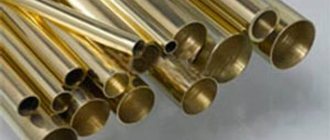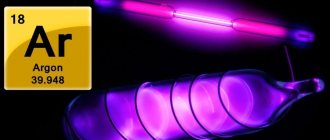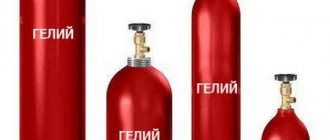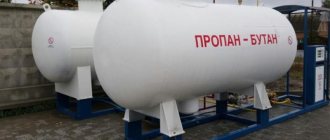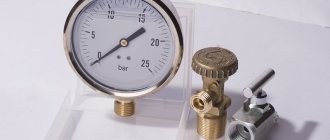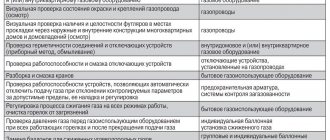Gas Density Table
Table of densities of liquefied propane-butane mixture (in t/m³) depending on its composition and temperature
| Propane/Butane ratio T, °C | −25 | −20 | −15 | −10 | −5 | 0 | 5 | 10 | 15 | 20 | 25 |
| 100/0 | 0,559 | 0,553 | 0,548 | 0,542 | 0,535 | 0,528 | 0,521 | 0,514 | 0,507 | 0,499 | 0,490 |
| 90/10 | 0,565 | 0,559 | 0,554 | 0,548 | 0,542 | 0,535 | 0,528 | 0,521 | 0,514 | 0,506 | 0,498 |
| 80/20 | 0,571 | 0,565 | 0,561 | 0,555 | 0,548 | 0,541 | 0,535 | 0,528 | 0,521 | 0,514 | 0,505 |
| 70/30 | 0,577 | 0,572 | 0,567 | 0,561 | 0,555 | 0,548 | 0,542 | 0,535 | 0,529 | 0,521 | 0,513 |
| 60/40 | 0,583 | 0,577 | 0,572 | 0,567 | 0,561 | 0,555 | 0,549 | 0,542 | 0,536 | 0,529 | 0,521 |
| 50/50 | 0,589 | 0,584 | 0,579 | 0,574 | 0,568 | 0,564 | 0,556 | 0,549 | 0,543 | 0,536 | 0,529 |
| 40/60 | 0,595 | 0,590 | 0,586 | 0,579 | 0,575 | 0,568 | 0,562 | 0,555 | 0,550 | 0,543 | 0,536 |
| 30/70 | 0,601 | 0,596 | 0,592 | 0,586 | 0,581 | 0,575 | 0,569 | 0,562 | 0,557 | 0,551 | 0,544 |
| 20/80 | 0,607 | 0,603 | 0,598 | 0,592 | 0,588 | 0,582 | 0,576 | 0,569 | 0,565 | 0,558 | 0,552 |
| 10/90 | 0,613 | 0,609 | 0,605 | 0,599 | 0,594 | 0,588 | 0,583 | 0,576 | 0,572 | 0,566 | 0,559 |
| 0/100 | 0,619 | 0,615 | 0,611 | 0,605 | 0,601 | 0,595 | 0,590 | 0,583 | 0,579 | 0,573 | 0,567 |
Distinctive features of liquefied gases:
- high vapor pressure;
- have no smell. To detect leaks in a timely manner, liquefied gases are given a specific odor - odorized with ethylmer-captan (C2H5SH);
- low temperatures and flammability limits. The ignition temperature of butane is 430°C, propane is 504°C. The lower flammability limit of propane is 2.3%, butane is 1.9%;
- propane, butane and their mixtures are heavier than air. In the event of a leak, liquefied gas can accumulate in wells or basements. It is prohibited to install equipment operating on liquefied gas in basement-type premises;
- transition to the liquid phase with increasing pressure or decreasing temperature;
- high calorific value. To burn LPG, a large amount of air is required (to burn 1 m³ of the gas phase of propane, 24 m³ of air is required, and butane - 31 m³ of air);
- large coefficient of volumetric expansion of the liquid phase (the coefficient of volumetric expansion of the liquid phase of propane is 16 times greater than that of water). Cylinders and tanks are filled to no more than 85% of their geometric volume. Filling more than 85% can lead to their rupture, subsequent rapid flow and evaporation of gas, as well as ignition of the mixture with air;
- as a result of evaporation of 1 kg of liquid phase of LPG at n. u. 450 liters of vapor phase is obtained. In other words, 1 m³ of the vapor phase of a propane-butane mixture has a mass of 2.2 kg;
- When 1 kg of propane-butane mixture is burned, about 11.5 kWh of thermal energy is released;
- liquefied gas evaporates intensely and, when it comes into contact with human skin, causes frostbite.
Example:
The density of a propane-butane mixture of 60% propane, 40% butane at an ambient temperature of -20°C will be 0.577 t/m3 or 577 kg/m3
Properties of LPG
To understand why propane is mixed with butane, you need to know the characteristics of each component, including their interaction with the external environment. From a molecular structure point of view, they are hydrocarbon compounds that can be stored in a liquid state, which greatly simplifies transportation and operation.
One of the conditions for the formation of liquid gas is high pressure, so it is stored in special tanks under a pressure of 16 bar. The second condition for the transition of hydrocarbon gases from one state to another is the external air temperature. Propane boils at -43°C, while the transformation from liquid to gaseous state in butane occurs at -0.5°C, which is the main difference between these hydrocarbons.
Table with some other properties of these gases
Additional information about the properties of liquefied hydrocarbon gas can be read in the article: propane-butane for a gas holder - properties and application features.
I. Video lesson: “Alkanes”
II. Homologous series of alkanes
Alkanes (saturated hydrocarbons) are aliphatic (acyclic), saturated hydrocarbons in which all the valences of carbon atoms not spent on the formation of simple C–C bonds are saturated with hydrogen atoms.
The general formula of alkanes is C nH2n+2
The table shows some representatives of a number of alkanes and their radicals.
| Formula | Name | Radical name |
| CH4 | methane | — CH3 methyl |
| C2H6 | ethane | — C2H5 ethyl |
| C3H8 | propane | — C3H7 drank |
| C4H10 | butane | — C4H9 butyl |
| C4H10 | isobutane | isobutyl |
| C5H12 | pentane | pentyl |
| C5H12 | isopentane | isopentyl |
| C5H12 | neopentane | neopentyl |
| C6H14 | hexane | hexyl |
| C7H16 | heptane | heptyl |
| C10H22 | dean | decile |
The table shows that these hydrocarbons differ from each other in the number of groups - CH2 -. Such a series of similar structures, having similar chemical properties and differing from each other in the number of these groups is called a homologous series. And the substances that make it up are called homologues.
Homologs are substances that are similar in structure and properties, but differ in composition by one or more homologous differences (- CH2 -).
Trainer: “Homologous series of alkanes”
III. Structure of alkanes
Main characteristics:
- spatial structure – tetrahedral
- sp3 – hybridization,
- ‹ HCH = 109 ° 28
- Carbon chain - zigzag (if n ≥ 3)
- σ – bonds (free rotation around bonds)
- length (-C-C-) 0.154 nm
- binding energy (-C-C-) 348 kJ/mol
All carbon atoms in alkane molecules are in a state of sp3 hybridization
The angle between the C-C bonds is 109°28′, so the molecules of normal alkanes with a large number of carbon atoms have a zigzag structure. The length of the C-C bond in saturated hydrocarbons is 0.154 nm (1 nm = 1*10-9 m).
Animation: “Formation of a methane molecule”
a) electronic and structural formulas
b) spatial structure
Structure of the ethane molecule C2H6
The structure of the C3H8 propane molecule is a zigzag chain.
Trainer: “Composition and structure of alkanes”
IV. Isomerism of alkanes
Characteristic is STRUCTURAL isomerism of the chain with C4
One of these isomers (n-butane) contains a straight carbon chain, and the other, isobutane, contains a branched one (isostructure).
The carbon atoms in a branched chain differ in the type of connection with other carbon atoms. Thus, a carbon atom bonded to only one other carbon atom is called primary , with two other carbon atoms - secondary , with three - tertiary , with four - quaternary .
With an increase in the number of carbon atoms in the molecules, the possibilities for chain branching increase, i.e. the number of isomers increases with the number of carbon atoms.
Comparative characteristics of homologues and isomers
V. Nomenclature of alkanes
Radicals have their own nomenclature (hydrocarbon radicals)
| Alkane - en С n H2n+2 | Radical (R) — il С n H2n+ 1 | ||
| FORMULA | NAME | FORMULA | NAME |
| methane | methyl | ||
| ethane | ethyl | ||
| propane | cut through | ||
| isopropyl (second-drank) | |||
| butane | n - butyl | ||
| sec-butyl | |||
| isobutane (2 – methylpropane) | isobutyl (per-isobutyl) | ||
| tert-butyl | |||
| neopentane (2,2-dimethylpropane) | neo-pentyl | ||
The number of identical substituents is indicated using multiplying prefixes :
- two – “di”
- three - "three"
- four – “tetra”
- five – “penta”
- six – “hexa”
- seven – “hepta”
- eight – “okta”
- nine – “nano”
To name saturated hydrocarbons, mainly systematic (IUPAC international nomenclature) and rational nomenclature are used.
Alkanes nomenclature
1. Rational nomenclature
According to rational nomenclature, alkanes are considered as derivatives of the simplest hydrocarbon - methane, in the molecule of which one or more hydrogen atoms are replaced by radicals. These substituents (radicals) are named according to their seniority (from less complex to more complex). If these substituents are the same, then their number is indicated. The name is based on the word “methane”:
2. Systematic nomenclature
Rules for systematic nomenclature:
1. In the formula of an alkane molecule, select the main chain - the longest.
2. Then we number this chain from the end to which the substituent (radical) is located closest. (If there are several substituents, then proceed so that the numbers indicating their position are the smallest.) We list the substituents alphabetically.
3. We name the hydrocarbon: first we indicate (by number) the location of the substituent, then we name this substituent (radical), and at the end we add the name of the main (longest) chain.
Thus, the hydrocarbon can be called: 2-methyl-4-ethylheptane (but not 6-methyl-4-ethylheptane).
Animation: “Formation of names of alkanes according to IUPAC nomenclature”
Animation: “Examples of different writing of formulas of the same substance”
Simulator No. 1: “Primary, secondary and tertiary carbon atoms”
Trainer No. 2: “Creating formulas of alkanes by name”
CORs
Video lesson: “Alkanes”
Animation: “Formation of a methane molecule”
Animation: “Formation of names of alkanes according to IUPAC nomenclature”
Animation: “Examples of different writing of formulas of the same substance”
Propane in industry
The technical form of the substance is used:
- for heating the cabins of heavy-duty vehicles;
- in welding and cutting of various metal structures;
- in perfumery, cosmetic production;
- for the production of varnishes, solvents;
- in the production of printed products at printing plants - it is used to make copy paper and printing ink;
- as a flavoring additive;
- for the production of refrigerant for refrigeration units and air conditioners;
- in the production and coloring of polymers;
- for heating workshops, greenhouses, industrial buildings.
Technological factor
In addition to the climate factor, there is a technological justification for why propane and butane are mixed. At oil refineries, during the processing of associated gases, propane and butane are produced in different quantities. Therefore, to optimize the raw material policy, these hydrocarbons are mixed together in a certain proportion. At the same time, regardless of the technology for producing liquefied hydrocarbon gas, the percentage of the two components must be within the limits established by GOST.
Why do they mix propane and butane in an autonomous gas supply system?
Considering the physicochemical characteristics of saturated hydrocarbons, their use largely depends on climatic conditions. Liquefied butane in its pure form will not work at subzero temperatures. Whereas the use of pure propane is contraindicated in hot climates, since high temperatures cause an excessive increase in pressure in the gas tank.
Since it is not practical to produce a separate grade of gas for each region, for the purpose of unification, GOST provides a mixture with a certain content of two components within the established standards. According to GOST 20448-90, the maximum butane content in this mixture should not exceed 60%, while for the northern regions and in the winter season the share of propane should be no less than 75%.
Percentage of gases at different times of the year
By the way, more articles from our blog about gasification are in this section.
Propane chlorination - an industrial method for producing perchlorethylene
Thermal chlorination of propane (250-350 °C) leads to a difficult-to-separate mixture of mono- and dichloropropanes; when the temperature rises to 400-500 °C, chloropropenes are formed; exhaustive chlorination in excess of chlorine at 550-600 °C is one of the industrial methods for producing perchlorethylene and CC14.
Thermal chlorination of propane in industry is carried out mainly for the purpose of producing 1,3-dichloropropane, from which cyclopropane is obtained. The mechanism of propane chlorination includes the following stages: propane and chlorine are heated separately in liquid form to 400-600°, after which chlorine is introduced into the propane flow at high speed so that the speed of its introduction is higher than the speed of flame propagation. The reaction is carried out in a tubular coil. As with the chlorination of methane, a stepwise supply of chlorine is used in such a way that in the section of the reaction pipe between the previous and subsequent supply of chlorine, the reaction has time to be completely completed. Removal of excess reaction heat is achieved by introducing an inert diluent, such as nitrogen or carbon dioxide, with propane. In some installations, the reaction coil is placed in a bath of molten salts for this purpose. The reaction products are cooled in a coil refrigerator, after which they enter a distillation column for separation. The released hydrocarbons are again sent to the reaction, and the chlorinated hydrocarbons are subjected to repeated rectification to be separated into mono-, di- and polychlorides. Distillation is carried out on several columns.
Transportation and storage
Since evaporation of liquid in LPG occurs even at 0 °C, these gases are usually stored strictly in closed containers.
Large consumers receive hydrocarbon gases in railway or road tanks, from which they are transferred to factory stationary containers.
Small consumers usually use cylinders.
Transport gases in accordance with the rules for the transportation of dangerous goods and the rules for the safe operation of pressure vessels.
First of all, it is worth considering the properties of propane. Its temperature in the cylinder should not exceed 15 degrees Celsius, otherwise there is a risk of fire.
Where is propane used?
Due to its high combustion temperature, propane is widely used as a fuel for cars, as a fuel element for gas stoves and heating systems. At enterprises it is used in the process of cutting metal and welding metal structures. In the food and chemical industries it is used as a solvent or food additive.
Propane-butane mixture
How do alkanes differ from other chemical compounds?
“Paraffins” are chemical compounds that have low reactivity. Alkanes do not dissolve in water and do not have any color. When burned, alkanes emit a lot of heat, and their flame is colorless or light blue. This class of compounds is actively used in industry, in particular in the synthesis of fuel and oil.
In the table you can see a list of substances that belong to the class of alkanes.

